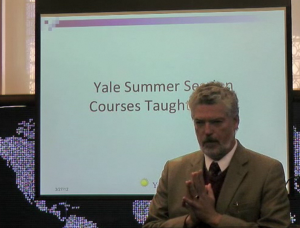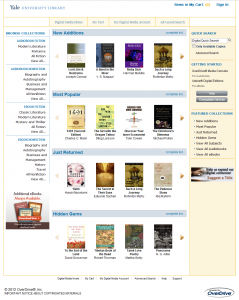Yale classes are already streamed around the world in high definition through the University’s revolutionary Open Yale Courses initiative. This program allows students to watch lectures and access certain class resources from anywhere at any time, but not for course credit. The idea that Yale credit cannot be earned through an online only program began to change in 2010, however, when Yale Summer Session Dean William Whobrey was approached by university officials about the possibility of introducing online courses for Yale credit in the summer of 2011. After a four course pilot, the experiment has been labeled a success and is expanding in the summer of 2012. To describe the ideas behind the Yale Summer Session Online courses, and the technology that powers the program, Dean William Whobrey and Richard Collins from the Yale Summer Session, and Lucas Swineford, from the Yale Broadcast and Media Center, came to TwTT to present on distance learning at Yale.
This program allows students to watch lectures and access certain class resources from anywhere at any time, but not for course credit. The idea that Yale credit cannot be earned through an online only program began to change in 2010, however, when Yale Summer Session Dean William Whobrey was approached by university officials about the possibility of introducing online courses for Yale credit in the summer of 2011. After a four course pilot, the experiment has been labeled a success and is expanding in the summer of 2012. To describe the ideas behind the Yale Summer Session Online courses, and the technology that powers the program, Dean William Whobrey and Richard Collins from the Yale Summer Session, and Lucas Swineford, from the Yale Broadcast and Media Center, came to TwTT to present on distance learning at Yale.
The first priority of program planners was to ensure that the courses offered online were held to the same high standards as their conventional
classroom counterparts. Besides putting each course through vetting by the Course of Study Committee, each class had to meet a strict set of criteria before students could be allowed to register. All online classes were versions of courses taught in previous years on the Yale campus in conventional classrooms, ensuring the existence of a comparative metric and effective subject material. To control for the possibility of an atypical student body, registration in the pilot was limited to current Yale undergraduates, and enrollment was capped at 25 students or fewer, creating a “seminar feel.” Despite the small class size, each course was also assigned a teaching fellow to maximize student access to material. Despite all these controls, Bill argues that what ultimately makes these classes unique is the outstanding teaching quality. All courses were taught by Yale ladder faculty, bringing students as close to a Yale campus experience as possible, regardless of their location in the world.
After settling on the general guidelines for the courses, the summer session team had to choose a learning management system (LMS) to be used as a platform for the program. From many vendors laying out a panoply of competing products, Rich Collins explained that the group ultimately settled on Pearson’s e-college suite, a cloud based learning environment in use at Columbia University and other peer institutions. Pearson’s excellent customer support and immediate technical assistance were weighted heavily in the decision process since faculty members worried that software problems might disrupt their classes – a fear that proved unfounded. The Pearson Learning Studio environment also allows significant flexibility in teaching. Professors could post readings and collect written assignments, initiate threaded discussions, broadcast recorded lectures, moderate group activities, and also administer exams and assessments. When students are in compatible time zones the software has a video conference feature which allows up to 25 participants to “meet” online in a live session that is recorded for later review. The LMS also has a facility that allows a common media space to be shared by all participants, which can include slide shows, podcasts, video clips, PDFs, or a white board where control can be limited to the professor or delegated to students. The Pearson LMS allows students and faculty to interact directly and use a variety of learning tools – a degree of personal attention that is nearly unique in the world of online classes – and the reason why students are charged regular summer session tuition for participation.
Given the variety of teaching styles made possible by the Pearson LMS, it is unsurprising that each of the four classes used a slightly different model, from campus based sections to seminar style interaction to a more conventional distance class based on recorded lectures. Tom Duffy’s Jazz and Race in Americamet at regular times on Yale’s campus, but used the online system to deliver additional content to students. Donald Brown’s course Computational Financebrought all students online simultaneously to work through problem sets together on on a virtual whiteboard. An online section of Craig Wright’s Brains of Genius ran at the same time as the classroom course, resulting in a distance experience that mirrored the classroom. Ellen Lust taught her class completely from overseas, recording lectures and guest speakers for students to watch, and also hosting online sections to ensure that students had an opportunity to discuss content face to face.
Bill pointed out that all of the classes are highly atypical in the distance learning community, and that this uniqueness is something that program administrators consider important. Indeed, the novel class formats have received very positive reviews from both students and faculty. Although the sample size was too small for rigorous scientific study, professors felt that they could teach effectively using the LMS, and that the classes were certainly worthy of Yale course credit. In a vote of confidence, all four faculty members plan to teach online again. Students also responded positively to the program, explaining that online classes actually proved to be more work than conventional equivalents.
The success of the online classes offered through the Yale Summer Session in 2011 has guaranteed that the program will be expanded in 2012. Although online classes pose significant technical and logistical challenges – Rich compared administering the program to running a live radio show – the successful learning outcomes and positive response from students and faculty seem to justify the extra effort. The program may also be expanded beyond the summer. Although it is unlikely that students will be able to take term-time classes online, Yale’s professional schools have expressed interest in the program, and may begin to offer their own distance learning programs. Despite fear of technical problems and poor learning outcomes, the Yale Summer Session Online Courses program has demonstrated the distance learning is a viable and effective complement to Yale’s traditional course offerings.
For full coverage of this session, please click the video below
(note a slight delay upon initial playback):







